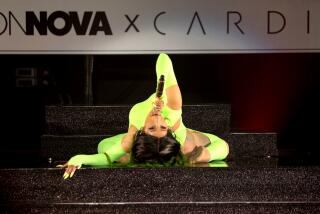Rome No Longer World Fashion Leader
- Share via
ROME — All roads may lead to Rome, but in the world of fashion it has become a dead-end street.
Long gone are the fabulous 1960s, when the rich and the famous came to Rome to be wined, dined and clothed in best “dolce vita” style.
The “Roman Holiday,” as lived by a bright-eyed princess whose wonderment at life in the Eternal City earned the late Audrey Hepburn an Oscar, is over.
Lights go out at 11 on the Via Veneto these nights. Grand hotels have signs in their lobbies telling tour groups when the bus will leave. Breaking with tradition, even Gucci joined the January sales.
The limelight has dimmed on the runway too. The fame of Italian couture and names such as Fabiani, Biki and Sorelle Fontana, who dressed Hepburn for that movie, have been relegated to a glorious past.
The biggest blow came a few years ago when Italy’s No. 1 couture designer, Valentino, took his collection to Paris.
“What’s the point of putting on a show for two-bit actresses and has-been contessas?” said Giancarlo Giammetti, Valentino’s right-hand man, referring to the absence of the jet set and international press from the semiannual Rome collections.
Valentino still keeps his headquarters in Rome, where he has set up a cultural center whose proceeds go to AIDS victims, but has abandoned the city otherwise.
He is not the only one.
Gianfranco Ferre also shows in Paris. Roberto Capucci, Roman couturier par excellence who has been absent from the capital’s runway for five years, has recently shown in Florence and Berlin. In the spring, his clothes will be part of a Paris exhibit dedicated to women.
“Rome has fallen apart and doesn’t seem to be able to pick up the pieces,” Capucci told the daily Il Messaggero.
Rome’s most recent high fashion shows for spring-summer 1993, which ended in January, produced little hope for the future.
Not that the clothes weren’t well made and elegant--the quality even seemed better than a few seasons ago--but there was nothing new on or off the runway.
Roman dowagers in basic black and pearls enthusiastically applauded their favorite designers, from Barocco to Balestra, Laug to Lancetti, but their loyalty rings no bells on cash registers.
Young designers, many of them noblemen like Prince Alessandro Torlonia, have surrounded themselves with blue-blooded fans who show their support in the purchase of wedding and ball gowns.
In order to make their clothes more attractive, the Rome designers have promised to hold prices down, meaning that a custom-made suit costs around $5,000 and ball gowns start at $10,000.
The style proposed by the Italian couture designers is a mixture of the sophisticated and the ethnic.
Sarong skirts and pajama pants in gay silk prints share the runway with trim suits and demurely ruffled party dresses. The garden party look is completed by the ever-present bag, gloves and wide-brimmed hat.
More to Read
Sign up for The Wild
We’ll help you find the best places to hike, bike and run, as well as the perfect silent spots for meditation and yoga.
You may occasionally receive promotional content from the Los Angeles Times.






